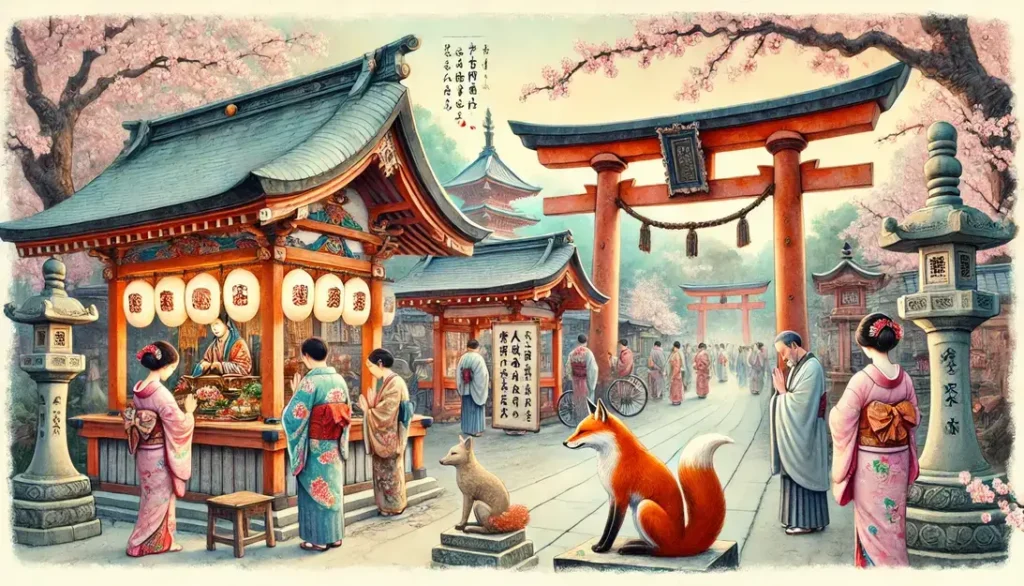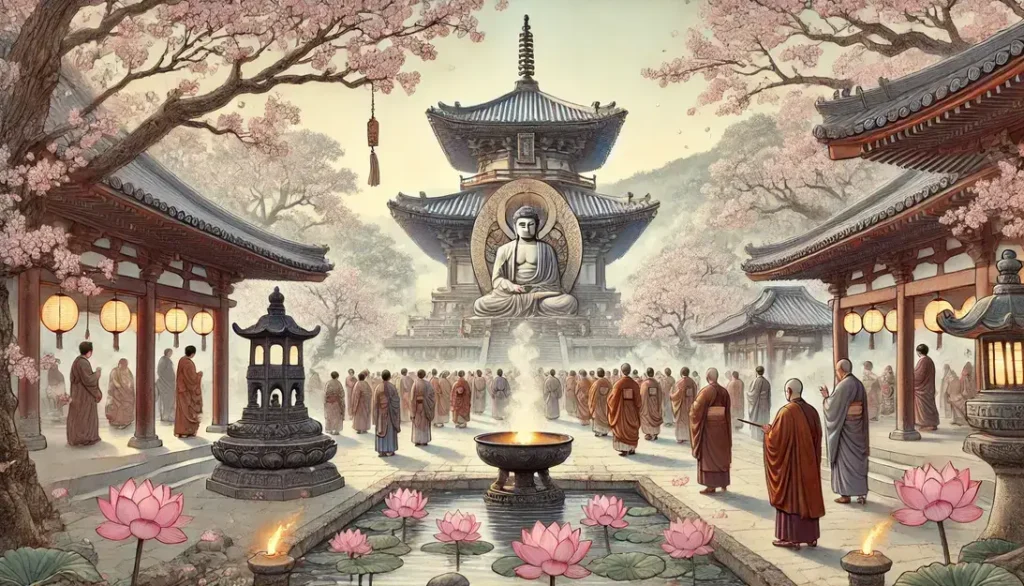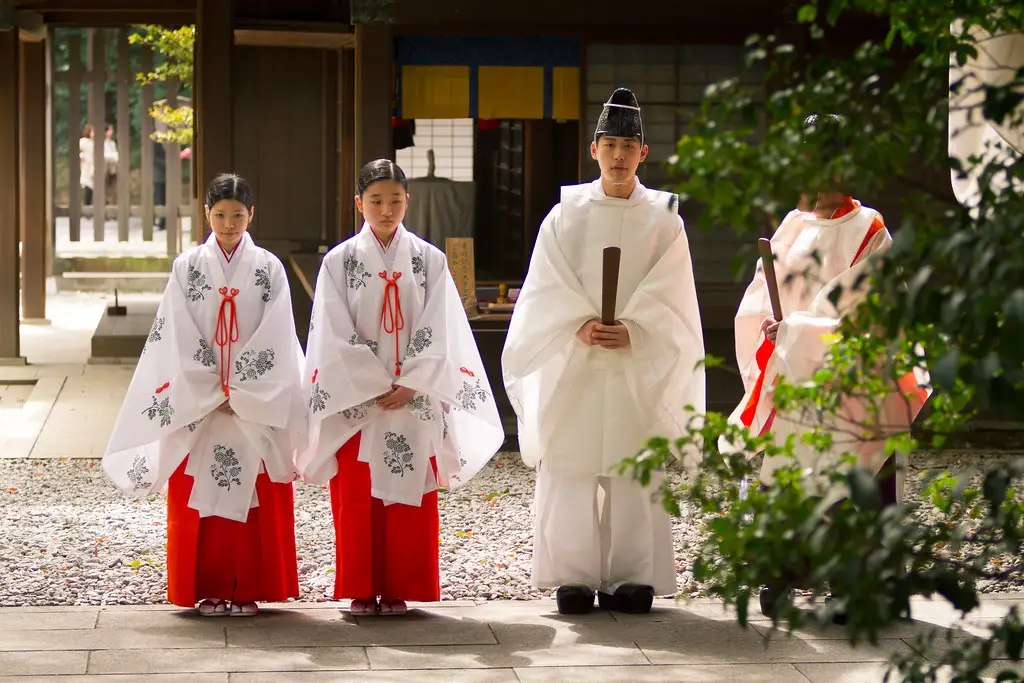Understanding the Main Religions in Japan: A Comprehensive Guide to Shintoism

Japan is a country with a rich tapestry of religious beliefs. The two main religions in Japan are Shinto and Buddhism. Shinto is the old religion of Japan. It focuses on special rituals and worship at places called shrines. Buddhism, on the other hand, helps people understand and solve spiritual problems.
What’s interesting is that many people in Japan follow both Shinto and Buddhism. This is because they don’t see any problem in honoring both Shinto and Buddhist gods. In fact, as many as 70.5% of the people in Japan follow Shinto, and 67.2% follow Buddhism.
Historical Context of Religion in Japan
A long time ago, people in Japan followed a religion called Shinto. Shinto means “the way of the gods” and it started during the Yayoi period (300 BCE – 300 CE). The people believed in many gods and spirits, and they worshiped them at special places called shrines.
Then, around the 6th century, things began to change. This was when Buddhism came to Japan from China and Korea. Buddhism is a religion that helps people understand and solve spiritual problems. The people in Japan liked Buddhism and started to practice it along with Shinto.
What’s interesting is that Chinese culture also had a big influence on Japan. For example, Taoism, a Chinese religion, was introduced to Japan and became part of their culture. So, the people in Japan were practicing Shinto, Buddhism, and Taoism all at the same time!
This mix of religions has helped shape Japan’s culture and traditions. Even today, many people in Japan still follow Shinto and Buddhism.

Shinto: The Indigenous Faith of Japan
Shinto is a unique religion that began in Japan many years ago. It teaches people to respect nature and the spirits, known as kami, that are believed to exist in everything around us. Those who follow Shinto value living in harmony, being pure, and showing respect for their families.
There are many special ceremonies and festivals in Shinto. These often include giving food and sake, which is a kind of rice wine, to the kami. Some of the biggest celebrations are Hatsumode, which is the first shrine visit of the New Year, Setsubun, where people throw beans to scare away bad spirits, and Shichi-Go-San, a festival that celebrates children growing up.
Shinto shrines are special places in this religion. They are considered the homes of the kami and are often located near beautiful natural features like waterfalls, caves, and mountains. These shrines have special gates, known as torii, that show you are entering a sacred place.

Buddhism in Japan
Buddhism is a religion that began in India and traveled to Japan around the 6th century. It arrived in Japan from China and Korea. At first, not many people in Japan followed Buddhism. But as time went on, it became very popular and started to influence Japanese culture.
In Japan, there are many different types of Buddhism. The largest ones are Pure Land Buddhism, Nichiren Buddhism, Shingon Buddhism, Zen Buddhism, and Tendai Buddhism. Each type has its own special beliefs and ways of practicing.
Buddhist temples are special places for Buddhists in Japan. These are places where people can learn about Buddhism, pray, and take part in religious events. Some temples are very old and have beautiful designs. They are often located in quiet places close to nature.

Syncretism in Japanese Religion
In Japan, two main religions, Shinto and Buddhism, blend together in a special way. This blending is called Shinbutsu-shugo. It started when Buddhism came to Japan around the 6th century. The Japanese people saw no problem in following both religions at the same time.
This blending of religions influences many parts of daily life in Japan. For example, it can be seen in architecture, festivals, and art. It also shapes the way people think and act.
One of the coolest things about this blending is how it shows up in festivals, or matsuri. These festivals are a big part of Japanese culture. They celebrate everything from flowers to children to ancient warriors. And guess what? These festivals don’t separate Shinto and Buddhist practices. They mix them together!

Other Religions in Japan
Besides Shinto and Buddhism, there are other religions in Japan. One of them is Christianity, which was brought to Japan by Portuguese missionaries in the 1500s. Today, less than 1% of people in Japan are Christian.
Islam is another religion in Japan. It makes up about 0.18% of the total population. Most Muslims in Japan come from other countries, but there are also Japanese people who have become Muslims.
Hinduism is also followed in Japan, mostly by people from India, Sri Lanka, and Nepal. As of 2022, there are about 166,550 Hindus in Japan.
In addition to these, there are new religions in Japan. These are religious movements that started in Japan since the middle of the 1800s. They are influenced by older religions like Buddhism and Shinto, as well as foreign religions like Christianity.

Religious Practices and Daily Life
Religion is a part of daily life in Japan. People often follow religious rituals at important events like births, weddings, and funerals. They also visit shrines or temples on New Year’s Day and take part in local festivals. These festivals, known as matsuri, usually have a religious background.
In Japanese families, religion plays a big role. Many homes have a Shinto shrine and a Buddhist altar. Families often pray together and participate in religious activities. This helps them feel closer to each other and their community.
Throughout the year, there are many seasonal religious activities in Japan. These activities help people connect with the changing seasons and the spirits or kami that come and go with them. They offer prayers for good harvests and safety from disease and disaster.
Religion in Japanese Art and Culture
Religion has a big effect on art and culture in Japan. In old art, ideas from Shinto and Buddhism are common. For example, pictures of nature in art are often seen as pictures of the holy world, because Shinto believes that gods or spirits live in things like trees and mountains.
Religion also affects books and performing arts. Many stories and plays have ideas from Shinto and Buddhism. They help us understand what the Japanese people value and believe in.
In today’s culture, religious symbols are still important. One of the most known symbols is the Torii gate. You can see these gates at Shinto shrines. They show the line between the physical and spiritual worlds. Another symbol is the Maneki-neko, or the waving cat, which is believed to bring good luck.

Religious Festivals and Holidays
In Japan, there are many special festivals and holidays that people celebrate. For the Shinto religion, there are a few big festivals every year. These include the Spring Festival, the Autumn Festival, and the Annual Festival. During these times, people pray for a good harvest and say thank you to the gods for the food they have grown.
For Buddhism, there are important days like Bodhi Day, which celebrates when Buddha became wise, and Nirvana Day, which remembers when Buddha reached a state of perfect peace. These holidays follow the lunar calendar and are celebrated with different activities.
Japan also has national holidays that come from religion. For example, New Year’s Day is a big celebration where people visit Shinto shrines for the first time in the year. Another example is the Coming-of-Age Day, which celebrates when people turn twenty years old.

Religious Sites and Pilgrimages
Japan has many special places for religion. For the Shinto religion, there are beautiful shrines like the Ise Grand Shrine, Meiji Jingu, and Fushimi Inari Shrine. These shrines are places where people go to pray and show respect to the spirits, or kami.
For Buddhism, there are many big temples in Japan. Some of the most known ones are Tōdai-ji Temple, Kiyomizu-dera Temple, and Senso-ji Temple. These temples are places where people can learn about Buddhism and take part in religious activities.
Japan also has popular paths for religious practice. These are paths that people walk as a part of their religion. The Kumano Kodo and the Shikoku 88 Temple Pilgrimage are two of the most known paths in Japan. These paths take you through beautiful landscapes and lead to many sacred places.

Religion in Japanese Education
In Japan, learning about religion in school is a little different than in some other places. Even though Japan is a modern country, religion is still important in education. For instance, public schools don’t teach a specific religion, but they do teach about different religions. This includes learning about the main religions in Japan, like Shinto and Buddhism.
Religion also helps shape moral education in Japan. Moral education is about teaching students to be good people. It includes lessons on being respectful, responsible, and kind to others. In Japan, these lessons are often influenced by local religions and beliefs.
In college, there are many programs for studying religion. These programs give students a chance to learn about many religions. They cover the religions’ histories and their impact on society. So, from grade school to college, religion is a big part of education in Japan.
Religion and Modern Japanese Society
Religion plays a big role in Japan today. It’s not just about what people believe in, but it also shapes how they act and what they think is right or wrong. Even if less than half of the people in Japan say they belong to a religious group, many still follow old traditions. They pray to gods in the Shinto religion, visit shrines and temples on special days, and even hold funerals in the Buddhist way.
The role of religion in Japan has changed over time. A long time ago, people in Japan worshipped nature spirits through a religion called Shinto. After World War II, Buddhism became popular again. Now, many people in Japan follow both Shinto and Buddhism.
The West has also influenced religion in Japan. In the 1500s, people from Portugal brought Christianity to Japan. Even though less than 1% of people in Japan are Christian, the religion has had a big impact on the country. This is especially true because of the schools that Christian missionaries started and the new ideas they brought from the West.
Impact of Religion on Japanese Architecture
Religion has a big impact on architecture in Japan. The traditional architectural styles, like Shinden-zukuri and Shoin-zukuri, were shaped by religious beliefs. These styles are known for their simplicity, use of natural materials like wood, and harmony with nature.

Religious buildings in Japan, like Shinto shrines and Buddhist temples, have special designs and symbols. For example, Shinto shrines often have beautiful gardens that symbolize the sacred relationship between humans and nature. Buddhist temples usually feature intricate woodwork and stunning calligraphy. These designs help create a sense of wonder and reverence.
Epilogue
In Japan, the main religions are Shinto and Buddhism. These religions have helped shape Japan’s culture, traditions, and even buildings. They also play a big part in everyday life, from family rituals to national holidays. There are also other religions like Christianity, Islam, and Hinduism.
Religion in Japan is like a colorful quilt, made with pieces of history, culture, and belief. It teaches us about the Japanese people’s respect for nature, their ancestors, and the spiritual world. It also shows us how different beliefs can live together in peace.
Looking to the future, religion in Japan will keep changing. As the world gets more connected, new ideas and beliefs might be introduced. But no matter what changes happen, the rich quilt of Japanese religion will stay, showing the country’s unique history and culture.




